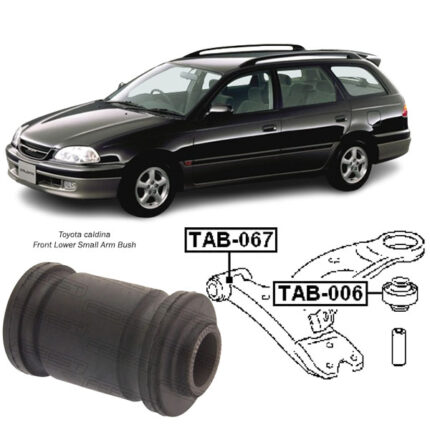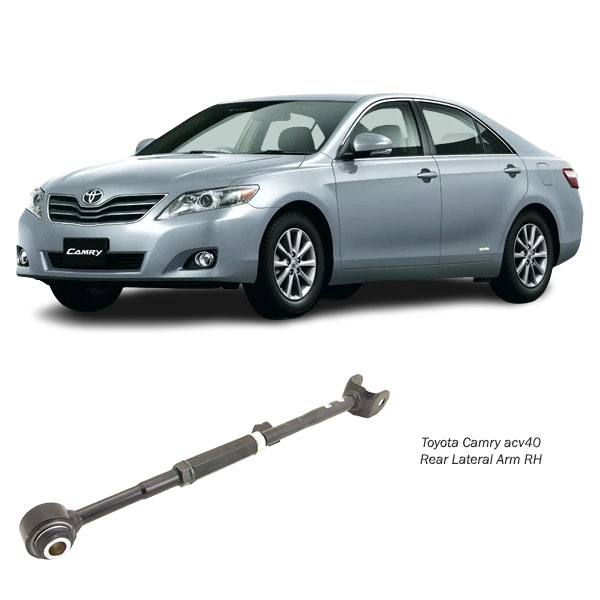Get Toyota Camry ACV40 Rear Lateral Arm RH 0125-5ACV40 in Kenya
The rear lateral arm is a suspension component that connects the rear wheel hub to the vehicle’s chassis or subframe. It is designed to manage the lateral (side-to-side) movement of the wheel while allowing for vertical movement to absorb road shocks.
Benefits;
Enhanced Stability and Handling
- Improved Cornering: The rear lateral arm helps maintain proper wheel alignment and camber, which is essential for stable and predictable handling, especially during cornering.
- Reduced Body Roll: By keeping the wheels properly aligned and minimizing lateral movement, the rear lateral arm reduces body roll, enhancing the vehicle’s stability during turns.
2. Better Ride Comfort
- Smooth Ride: High-quality rear lateral arms absorb and mitigate road vibrations and shocks, providing a smoother ride for passengers.
- Reduced Noise: Well-designed lateral arms can help dampen noise, vibration, and harshness (NVH), contributing to a quieter cabin environment.
3. Improved Safety
- Maintained Traction: Properly functioning rear lateral arms ensure that the wheels maintain consistent contact with the road, enhancing traction and reducing the risk of skidding or loss of control.
- Accurate Steering Response: By maintaining precise wheel alignment, the rear lateral arm contributes to accurate steering response, improving the driver’s ability to maneuver the vehicle safely.
4. Enhanced Durability and Longevity
- Reduced Wear on Tires: Proper wheel alignment maintained by the rear lateral arm prevents uneven tire wear, extending the lifespan of the tires and ensuring consistent performance.
- Lower Suspension Wear: By reducing unnecessary movement and absorbing shocks, rear lateral arms help protect other suspension components from excessive wear and tear.
5. Cost Savings
- Lower Maintenance Costs: Proper functioning of the rear lateral arms reduces the need for frequent wheel alignment and suspension repairs, leading to long-term savings on maintenance costs.
- Extended Component Life: By reducing wear on suspension and steering components, high-quality rear lateral arms help extend the overall lifespan of the vehicle’s suspension system.
6. Performance Enhancement
- Improved Handling Performance: For performance vehicles, upgraded rear lateral arms can provide better handling characteristics, making the vehicle more responsive and agile during high-speed maneuvers.
- Customization: High-performance lateral arms often allow for adjustments to camber and toe settings, enabling enthusiasts to fine-tune their suspension for specific driving conditions or track performance.
7. Enhanced Vehicle Control
- Better Load Distribution: The rear lateral arm helps distribute the vehicle’s weight more evenly across the suspension system, improving balance and control.
- Minimized Suspension Flex: High-quality lateral arms reduce suspension flex, ensuring that the wheels remain in the correct position relative to the vehicle’s frame, which is crucial for maintaining control during aggressive driving.
8. Resistance to Corrosion and Wear
- Durable Materials: High-quality rear lateral arms are often made from durable materials such as high-strength steel or aluminum, which resist corrosion and wear, providing long-lasting performance.
- Protective Coatings: Many lateral arms are treated with protective coatings to resist corrosion and damage from road debris, further enhancing their longevity.
Signs a car needs another Rear Lateral Arm;
Uneven Tire Wear
- Explanation: Excessive or uneven tire wear on the rear tires can indicate alignment issues caused by a faulty rear lateral arm.
- Inspection: Check for uneven tread wear patterns, such as more wear on the inner or outer edges of the tires.
2. Poor Handling and Stability
- Explanation: A damaged or worn rear lateral arm can cause instability and poor handling, especially during cornering.
- Symptoms: The car may feel loose or unstable, particularly when turning or driving on uneven surfaces.
3. Noises from the Suspension
- Explanation: Worn bushings or joints in the rear lateral arm can create noise.
- Symptoms: Listen for clunking, knocking, or rattling sounds coming from the rear suspension, especially when driving over bumps or potholes.
4. Vibration or Shimmy
- Explanation: A failing rear lateral arm can cause vibrations in the vehicle.
- Symptoms: Noticeable vibrations or shimmying in the steering wheel or throughout the car while driving, particularly at higher speeds.
5. Misalignment
- Explanation: A bent or damaged rear lateral arm can cause the wheels to go out of alignment.
- Symptoms: The car may pull to one side, and the steering wheel may not be centered when driving straight.
6. Unusual Tire Movement
- Explanation: If the rear lateral arm is loose or damaged, the rear wheels may not maintain proper positioning.
- Inspection: Observe the rear tires while someone else drives the car slowly; look for unusual movement or wobbling.
7. Visual Inspection
- Explanation: Physical damage or wear can often be seen upon close inspection.
- Inspection: Look for visible signs of damage, such as bent or cracked arms, worn or cracked bushings, and rust or corrosion on the arm.
8. Difficulties in Alignment
- Explanation: Difficulty achieving proper alignment during a routine wheel alignment check can indicate a problem with the rear lateral arm.
- Symptoms: Alignment technicians may report problems with adjusting the alignment or may notice that the alignment does not hold.
Follow us on Facebook for more parts.



